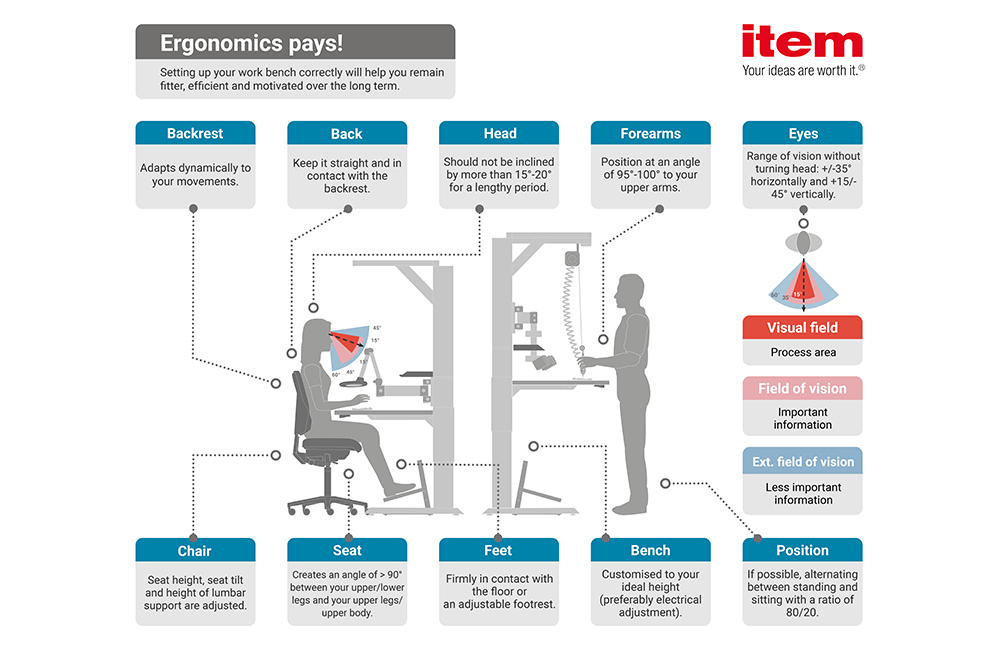While ergonomics in the working world may have been a niche topic at one time, those days are long gone. Laws, standards and recommendations make it quite clear – ergonomics is a must.
Ergonomics can actually be summed up in a single sentence. Work adapts to people – and not the other way around. Every employee is unique – and ergonomics means taking this seriously. It goes without saying that no two people are physically identical. It is therefore vital that every work bench and chair can be adjusted so that nobody has to contort themselves into unnatural positions. Irrespective of whether we’re talking about office work or manual production, optimising the working environment leads to a true win-win situation. An ergonomic approach eases the physical strain on the workforce and helps them maintain their performance. This also boosts profitability. Health protection and targeted efficiency improvements, therefore, go hand in hand. However, since the principles of ergonomic workplace design are rooted in scientific knowledge, ergonomics is certainly not intuitive. Even the literal meaning of ergonomics points to this fact, since the term is derived from the Greek words “ergon” (work or labour) and “nomos” (natural laws). Ergonomics is therefore all about the science relating to the rules of work, which are even prescribed by law. But what do these rules and laws say, and what do employers need to bear in mind when it comes to ergonomics in the workplace? The following examples are from Germany, and therefore many sources are available only in German.

Ergonomics study for industry
This study shows which ergonomic measures are already being used in manual production. Find out more and see how you compare – how much progress has your company made?
GET YOUR COPY NOW
Employers’ obligations – enshrined in law
Ergonomics is part and parcel of preventive occupational health and safety. This means that its purpose is to promote health and prevent illness. Stipulations about ergonomic workplace design are therefore set out in various laws. Companies should look in particular at the German Occupational Safety and Health Act (ArbSchG) and Workplace Ordinance (ArbStättV). Even though the term “ergonomics” does not actually appear in the Occupational Safety and Health Act, there are some insightful passages. For example, according to section 3 of the ArbSchG, the employer has a duty to take the necessary measures that “influence the safety and health of workers at work. He shall examine the effectiveness of those measures and, where necessary, adapt them to changing circumstances.” Another particularly interesting sentence reads: “His aim in doing so shall be to improve the safety and health protection of the workers.” All in all, what is being described here are three duties for companies that are fixed elements of ergonomics – health protection, analysis of the existing situation and optimisation.
The employer also has a duty to eliminate risks by putting occupational health and safety measures in place. Section 5 of the ArbSchG includes the following aspects of ergonomics:
- “The design and setup of the workstation and the work place“
- “The design of the working and production methods, work processes and working time and their interplay”
- “Psychological stress at work”
Psychological stress is an area of ergonomics and occupational health and safety that is often overlooked. When the basic principles of ergonomics are ignored, this can result in employees suffering from tension and headaches, which can in turn cause psychological stress.
Workplace design – the Workplace Ordinance and Operational Safety Ordinance
In terms of legal requirements and guidelines relating to ergonomics in the workplace, the Workplace Ordinance (ArbStättV) is particularly important. It states that, when “setting up workplaces”, the employer must also take “occupational medicine” and “ergonomic requirements“ into consideration. If risks are present, then the employer must “assess all possible risks to the safety and the health of the workers“ and, in doing so, take into account the “effects of the work organisation and the work processes in the workplace”. Companies must then take measures in accordance with the state of the art, occupational medicine and hygiene.
The employer must ensure that working equipment is used safely and that the principles of ergonomics are heeded. (Operational Safety Ordinance, BetrSichV)
However, this is by no means all. “Other established ergonomic findings are to be taken into account.” Ergonomics is a field within occupational science, so its principles are part and parcel of this discipline. The Operational Safety Ordinance (BetrSichV) puts this even more clearly: “The employer must ensure that working equipment is used safely and that the principles of ergonomics are heeded.”
Ergonomics and occupational health and safety – classification of work arrangement guidelines
Besides legal requirements, there are “Technical Rules for Workplaces”, which are also known as ASRs (short for “Arbeitsstättenregeln” in German). These technical rules are drawn up by the Committee for Workplaces (ASTA) and the German Federal Institute for Occupational Safety and Health (BAuA). Although these rules have no legal force, there is a “presumption of conformity” that applies – in other words, if employers comply with the ASR requirements in the workplace, it can be presumed that their measures will also be in compliance with the terms of the Workplace Ordinance. Aspects of ergonomic workplace design are covered, for example, in the following ASR documents:
- ASR A1.2: Room dimensions and movement areas
- ASR A3.4: Lighting and lines of sight
- ASR A3.7: Noise
- ASR V3: Risk assessment
There are many more guidelines and standards relating to ergonomics in the workplace. You can find these, for instance, in the “Technical Rules for Operational Safety” (Technische Regeln für Betriebssicherheit, TRBS), which expand on the Operational Safety Ordinance. Examples of these rules include “TRBS 1151: Hazards at the human / work equipment interface – ergonomic and human factors, work system” and “AMR No. 13.2: Activities involving significantly increased physical loads that pose health risks for the musculoskeletal system”. The most important DIN standards in relation to ergonomics in the workplace include DIN EN ISO 6385 (“Ergonomic principles in the design of work systems”), DIN 33402 (“Ergonomics – Human body dimensions”) and DIN EN ISO 10075 (“Ergonomic principles related to mental workload”).
The role of the work bench at an ergonomic assembly workstation
It is therefore crystal clear that ergonomics is mandatory – and not optional – for employers. Experts need to decide how best to apply ergonomics on a case-by-case basis. However, a few examples from manual production help shed light on what ergonomics is all about. For example, a height-adjustable work bench at a manual assembly workstation is a must. The same principle applies as in an office – a height-adjustable work bench or desk means staff can switch easily between sitting and standing, which eases the strain on them considerably. The Work Bench System from item also features an electric height-adjustment mechanism. This means staff can save their personal settings and call them up again at the touch of a button. Another particularly practical feature is the item Work Bench Configurator, which is available to use free of charge and makes planning manual assembly work benches easier than ever before.
When it comes to ergonomic chairs, the following features are ideal:
- Synchronised movement of the seat and backrest
- Seat – should dip forward slightly and rotate
- Backrest – height adjustment and a tilt mechanism incorporating tension control
- Castors with brakes and – in the case of counter chairs with elevated seats – castors that lock in position when under load
Chairs with this kind of seat and backrest support dynamic sitting, making it easy for employees to alter their position and posture. Chairs from the item Work Bench System offer this comfort and convenience, since they are both safe and movable thanks to their special castors.

Ergonomic work bench design factors in the handling area, too
The handling area is a perfect example that illustrates why flexible adjustment options are so crucial. The handling area is the space at the work bench where staff can reach every point vertically or horizontally with one or both hands without having to move out of position, whether they are sitting or standing. The one-handed zone is directly in front of the worker. Frequently used tools and materials are positioned here to prevent awkward and unnecessary twisting of the body. Objects that are used less often are placed in the extended one-handed zone in the outermost reaches of the handling area. Important materials should not be placed beyond the extended one-handed zone. The best place for these materials is the two-handed zone, where the worker has both hands in their direct field of vision and can work optimally.


Optimal organisation of tools and materials
Since no two people are exactly the same size or shape, each person’s handling area is unique, too. It is therefore important that the way tools and materials are organised at the work bench can also be easily adapted. With its comprehensive range of components, the item Work Bench System covers all possible options. Pivot arms, in particular, play a very important role here and can be fitted out with various components:
- Parts containers for holding small parts
- Trays for holding boxes, tools and workpieces
- Hooks, holders and containers for storing tools
Thanks to the pivot arms, materials and tools are therefore precisely arranged to suit each employee’s personal handling area. Awkward movements and uncomfortable postures can therefore be specifically avoided.
Ergonomic lighting – information and recommendations
Lighting at the work bench is one of the less well-known ergonomic factors. However, in the case of both office work and manual assembly, lighting has an impact on productivity. You need adequate lighting, but that’s not all that matters – lighting that can be adapted to the specific circumstances is even more crucial. Otherwise, employees may lose concentration and suffer from headaches and other fatigue symptoms. Lighting, therefore, also has a major impact on both mood and motivation. When it comes to lighting at assembly work benches, there are important aspects to consider – a customised lighting level, illuminating specific areas, an appropriate colour temperature and even, glare-free reflections. The unit of measurement used for the level of lighting (illuminance) is the lux (lx). The following lighting levels are ideal for manual assembly work:
- Basic assembly work: 200 lx
- Medium-precision assembly work: 300 lx
- Intricate assembly work: 500 lx
- High-precision assembly work: 750 lx
- Precision mechanics and micro mechanics: 1000-1500 lx
Specific areas of the work bench can be lit precisely using LED spotlights that are flexibly adjustable and offer high levels of lighting. An LED spotlight such as the Spotlight 6W LED 10° from item also features an adjustable dimmer function. Its colour temperature is 4000 K – also called “neutral white” – which has proved ideal for manual assembly work, since it boosts concentration.
Are you interested in work bench design in production? Then we have something that’s right up your street! Simply subscribe to the item blog by completing the box at the top right.





